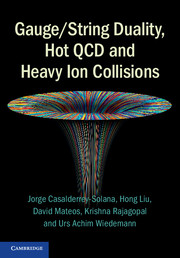Book contents
- Frontmatter
- Contents
- 1 Opening remarks
- 2 A heavy ion phenomenology primer
- 3 Results from lattice QCD at nonzero temperature
- 4 Introducing the gauge/string duality
- 5 A duality toolbox
- 6 Bulk properties of strongly coupled plasma
- 7 From hydrodynamics to far-from-equilibrium dynamics
- 8 Probing strongly coupled plasma
- 9 Quarkonium mesons in strongly coupled plasma
- 10 Concluding remarks and outlook
- Appendix A Green–Kubo formula for transport coefficients
- Appendix B Hawking temperature of a general black brane metric
- Appendix C Holographic renormalization, one-point functions, and a two-point function
- Appendix D Computation of the holographic stress tensor
- References
- Index
7 - From hydrodynamics to far-from-equilibrium dynamics
Published online by Cambridge University Press: 05 July 2014
- Frontmatter
- Contents
- 1 Opening remarks
- 2 A heavy ion phenomenology primer
- 3 Results from lattice QCD at nonzero temperature
- 4 Introducing the gauge/string duality
- 5 A duality toolbox
- 6 Bulk properties of strongly coupled plasma
- 7 From hydrodynamics to far-from-equilibrium dynamics
- 8 Probing strongly coupled plasma
- 9 Quarkonium mesons in strongly coupled plasma
- 10 Concluding remarks and outlook
- Appendix A Green–Kubo formula for transport coefficients
- Appendix B Hawking temperature of a general black brane metric
- Appendix C Holographic renormalization, one-point functions, and a two-point function
- Appendix D Computation of the holographic stress tensor
- References
- Index
Summary
In Chapter 6 we have described ways in which holographic calculations have yielded insight into various properties of strongly coupled plasma that is at rest and in thermal equilibrium or, in our discussion of transport properties, infinitesimally close to being at rest and in thermal equilibrium. In this chapter, we release these restrictions. By the end of the chapter, we will be analyzing violent dynamical processes that are initially very far from thermal equilibrium and that may provide a caricature of the dynamics in the earliest moments of a heavy ion collision, or at least what that dynamics would be if the physics then was already strongly coupled. Before the development of gauge/gravity duality, there were no reliable quantum field theoretical calculations valid in far-from-equilibrium, highly time-dependent, strongly coupled matter. We shall build up the holographic tools that can now provide such calculations in stages over the course of the chapter. In doing so we shall make the connections to heavy ion physics manifest throughout, but it is important to realize that these tools are of considerable value in any other quantum field theoretical context in which the physics is strongly coupled and the questions of interest include far-from-equilibrium dynamics and thermalization.
We begin by letting the strongly coupled plasma move. In Sections 7.1 and 7.2 we show how to construct the gravitational description of solutions to the hydrodynamic equations for strongly coupled plasma in motion. That is, we continue to assume local thermal equilibrium, but we let the plasma move and flow.
- Type
- Chapter
- Information
- Gauge/String Duality, Hot QCD and Heavy Ion Collisions , pp. 194 - 260Publisher: Cambridge University PressPrint publication year: 2014

